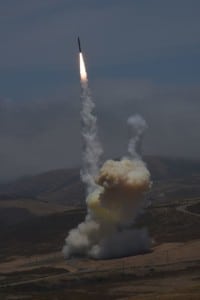The Senate Armed Services Committee’s draft of the FY ’21 defense authorization bill pushes the Missile Defense Agency (MDA) to develop and produce an interim Ground-Based Interceptor (GBI) by 2026.
“Not later than 30 days after the date of the enactment of this Act, the Secretary of Defense, acting through the Director of the Missile Defense Agency and in coordination with the Under Secretary of Defense for Acquisition and Sustainment, the Commander of the United States Northern Command, and the Commander of the United States Strategic Command, shall commence carrying out a program to develop an interim ground-based interceptor capability,” the bill says.

The interim capability is directed to use sound acquisition practices, address the majority of current and near- to mid-term projected ballistic missile threats to the U.S. homeland, at minimum meet the proposed capabilities of the since-cancelled Redesigned Kill Vehicle (RKV) program, leverage existing kill vehicle and booster technology, and “appropriately balance interceptor performance with schedule of delivery.”
DoD scraped the RKV program last August due to significant delays and potentially hundreds of millions of dollars in cost overruns required to fix deficiencies. In the FY ’20 budget request, MDA said they are requesting $4.9 billion to start development of a Next Generation Interceptor (NGI) over the next five years (Defense Daily, Feb. 11).
MDA previously planned to install 20 new interceptors featuring the RKV in new missile silos already procured at the main Ground-based Missile Defense (GMD) system site at Fort Greeley, Alaska.
In March, Undersecretary of Defense for Research and Engineering Mike Griffin said he expects the NGI program to take about 10 years to reach deployment. The NGI will not only provide a new kill vehicle at the tip of the interceptor, but also a new booster (Defense Daily, March 11).
MDA released a Request For Proposals for NGI in April and the agency intends to award two contracts to allow the simultaneous development of two NGI options through the critical design review period to produce an interceptor in a shorter time. At the time the agency said it expects the total cost of designing, developing and fielding 20 NGIs will be over $11 billion (Defense Daily, April 24).
The SASC provision directs the MDA Director to coordinate with the Undersecretary of Defense for Acquisition and Sustainment, commander of Northern Command, and U.S. Strategic Command to “conduct rigorous flight testing of the interim ground-based interceptor; and deliver 20 new ground-based interceptors by 2026.”
The bill also lists the minimum capabilities and criteria for the interim GBI system. This includes vehicle-to-vehicle communications; vehicle-to-ground communications; kill assessment capability; ability to counter advanced countermeasures, decoys, and penetration aids; producibility and manufacturability; use of technology involving high technology readiness levels; options to integrate the new kill vehicle onto other missile defense interceptor vehicles beyond GBIs; and sound acquisition processes.
As part of this new program, the MDA director is directed to include a report on the funding profile necessary for the interim GBI in the FY ’22 budget justification materials.
However, the bill allows the Secretary of Defense to waive the requirements if he certifies to the defense committees that the technology development is not technically feasible, the interim capability is not in the national security interest, or NGI can deliver a capability before the interim GBI.
If the secretary does waive the requirements, his office is required to commit an explanation of the rationale to the defense committees, an estimate of projected rogue nation threats to the U.S. homeland not defended against until NGI is fielded, and an updated schedule for the development and deployment of NGI.
This new capability goes far beyond what the House Armed Services Committee is reviewing in its version of the FY ’21 defense authorization bill.
The House version requires the MDA director notify the defense committees of any changes made to NGI within seven days and requires an analysis of alternatives for a complete missile defense architecture using regional systems for homeland defense while NGI is in development. This includes systems like the Standard Missile-3 Block IIA Aegis interceptors and Terminal High Altitude Area Defense system (Defense Daily, June 21).